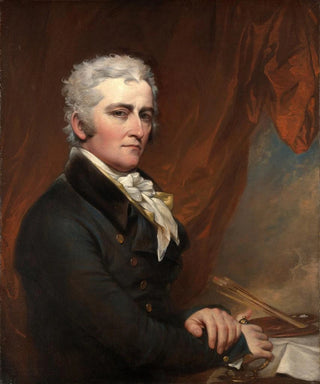Art print | Self-portrait - John Trumbull


View from behind

Frame (optional)
John Trumbull's self-portrait, a hallmark of 18th-century art, offers a captivating window into the mind of a man whose life was shaped by the tumult of the American Revolution. This painting, which serves as an intimate reflection of the artist, transcends mere representation to provide an introspective look at identity and creativity. Through this portrait, Trumbull not only captures his physical appearance; he also evokes his commitment to the ideals of his time, as well as his role as a witness and participant in history. The art print of this self-portrait allows us to understand not only the artist but also the historical context surrounding him, inviting viewers to explore the depths of his soul.
Style and uniqueness of the work
The style of Trumbull's self-portrait is distinguished by its finesse and precision. The artist, trained in the traditions of European academic painting, applies chiaroscuro techniques that give his face striking depth. The meticulous details of his expression, along with the skillful use of light, create an atmosphere of intimacy that encourages the viewer to establish a personal connection with the piece. Trumbull chooses rich colors and subtle nuances to evoke dignity and intelligence, traits that characterize not only his appearance but also his character. The background, simple and unadorned, highlights the main subject and reflects a desire to focus attention on the individual, thereby enhancing the emotional impact of the painting.
The artist and his influence
John Trumbull, often regarded as the painter of the American Revolution, captured the spirit of his time through his historical works. Born in 1756, he witnessed the birth of a nation and immortalized key events through his painting. His artistic approach, which combines realism and idealization, influenced many American artists. Trumbull also played a crucial role in promoting art in the United States, contributing to the founding of the Pennsylvania Academy of the Fine Arts and supporting young talents. His self-portrait, far more than a simple image, is

Matte finish

View from behind

Frame (optional)
John Trumbull's self-portrait, a hallmark of 18th-century art, offers a captivating window into the mind of a man whose life was shaped by the tumult of the American Revolution. This painting, which serves as an intimate reflection of the artist, transcends mere representation to provide an introspective look at identity and creativity. Through this portrait, Trumbull not only captures his physical appearance; he also evokes his commitment to the ideals of his time, as well as his role as a witness and participant in history. The art print of this self-portrait allows us to understand not only the artist but also the historical context surrounding him, inviting viewers to explore the depths of his soul.
Style and uniqueness of the work
The style of Trumbull's self-portrait is distinguished by its finesse and precision. The artist, trained in the traditions of European academic painting, applies chiaroscuro techniques that give his face striking depth. The meticulous details of his expression, along with the skillful use of light, create an atmosphere of intimacy that encourages the viewer to establish a personal connection with the piece. Trumbull chooses rich colors and subtle nuances to evoke dignity and intelligence, traits that characterize not only his appearance but also his character. The background, simple and unadorned, highlights the main subject and reflects a desire to focus attention on the individual, thereby enhancing the emotional impact of the painting.
The artist and his influence
John Trumbull, often regarded as the painter of the American Revolution, captured the spirit of his time through his historical works. Born in 1756, he witnessed the birth of a nation and immortalized key events through his painting. His artistic approach, which combines realism and idealization, influenced many American artists. Trumbull also played a crucial role in promoting art in the United States, contributing to the founding of the Pennsylvania Academy of the Fine Arts and supporting young talents. His self-portrait, far more than a simple image, is






